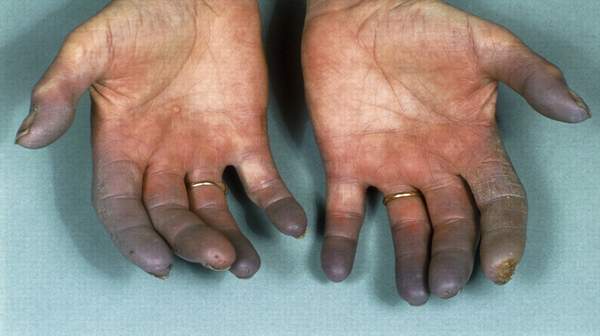What's in this article?
Buerger’s Disease Overview
Buerger’s disease, also called thromboangiitis obliterans, is a disease that causes blockages in the blood vessels of your feet and hands. The blood vessels become inflamed, which reduces blood flow. Blood clots that further clog blood vessels also develop. The disease causes pain and can lead to tissue damage and, in severe cases tissue death (gangrene).
Buerger’s disease affects 20 out of 100,000 people per year in the United States, according to statistics gathered by the Centers for Disease Control and Prevention. (CDC) This condition can affect people of any race and age group. However, it mainly affects Asian or Middle Eastern men between the ages of 20 and 40 who heavily use or have heavily used tobacco products, including chewing tobacco.
Symptoms of Buerger’s Disease
Buerger’s disease symptoms include:
- Pain that may come and go in your legs and feet or in your arms and hands. This pain typically occurs when you use your hands or feet and eases when you stop that activity (claudication).
- Inflammation along a vein just below the skin’s surface (due to a blood clot in the vein).
- Fingers and toes that turn pale when exposed to cold (Raynaud’s phenomenon).
- Painful open sores on your fingers and toes.
Who gets Buerger’s Disease?
The classic Buerger’s Disease patient is a young male (e.g., 20–40 years old) who is a heavy cigarette smoker. More recently, however, a higher percentage of women and people over the age of 50 have been recognized to have this disease. Buerger’s disease is most common in the Orient, Southeast Asia, India and the Middle East, but appears to be rare among African–Americans.
Causes of Buerger’s Disease
It isn’t clear what triggers Buerger’s disease. It’s possible that some people may have a genetic predisposition to the disease. The condition is characterized by swelling in the arteries and veins of the arms and legs. The cells that cause the inflammation and swelling and eventually blood clots form in the vessels leading to your hands and feet and block the blood flow to those parts of your body.
Reduced blood flow means that the skin tissue in your hands and feet doesn’t get adequate oxygen and nutrients. This leads to the signs and symptoms of Buerger’s disease, beginning with pain and weakness in your fingers and toes and spreading to other parts of your arms and legs.
Recognizing the Symptoms of Buerger’s Disease
Buerger’s disease usually starts with pain in the areas affected, followed by weakness in the same areas. Symptoms include:
- pain in your hands and feet or your legs and arms (this pain may come and go)
- open sores on your toes or fingers
- inflamed veins
- pale toes or fingers when in cold temperatures
Risk factors of Buerger’s Disease
Cigarette smoking greatly increases your risk of Buerger’s disease. Heavy cigarette smokers (people who smoke one and a half packs a day or more) are most likely to develop Buerger’s disease, though it can occur in people who use any form of tobacco, including cigars and chewing tobacco. People who smoke hand-rolled cigarettes using raw tobacco may have the greatest risk of Buerger’s disease.
It isn’t clear how tobacco use increases your risk of Buerger’s disease, but virtually everyone diagnosed with Buerger’s disease uses tobacco. It’s thought that chemicals in tobacco may irritate the lining of your blood vessels, causing them to swell. Rates of Buerger’s disease are highest in areas of the Middle East and Far East where heavy smoking is most common.
Although secondhand smoke isn’t thought to be a major risk factor for Buerger’s disease, if you’re diagnosed, you should stay away from people who are smoking. Secondhand smoke could worsen your condition.
Tests and Diagnosis of Buerger’s Disease
There is no test to determine if you have Buerger’s disease. However, there are tests your doctor can perform to rule out other conditions. A simple blood test can help your physician pinpoint whether your symptoms are from lupus, diabetes, or blood clotting disorders, which can display the same symptoms as Buerger’s disease.
In some cases, an angiogram which checks the health of your arteries may be necessary. In this test, your doctor injects a dye into your artery and then performs an X-ray of the area to view blockages in your arteries.
Another test your physician may perform is called an Allen test. This is a noninvasive test that requires you to make a tight fist while your physician presses on the artery of your hand. When you open your fist and your doctor releases the pressure from the artery, your hand should quickly turn from pale to its original color. If the color changes slowly, this might be an indication of Buerger’s disease.
Treatment and Course of Buerger’s Disease
It is essential that patients with Buerger’s disease stop smoking immediately and completely. This is the only treatment known to be effective in Buerger’s disease. Patients who continue to smoke are generally the ones who require amputation of fingers and toes.
Despite the clear presence of inflammation in this disorder, anti-inflammatory agents such as steroids have not been shown to be beneficial. Similarly, strategies of anticoagulation (thinning of the blood with aspirin or other agents to prevent clots) have not proven effective. The only way to prevent the progression of the disease is to abstain from all tobacco products.






